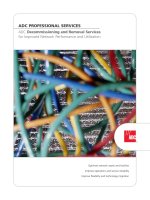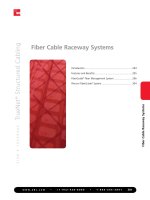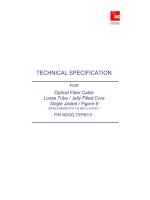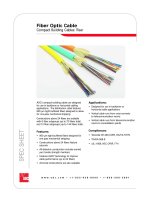Tài liệu ADC Refines Reliability for Syncrude doc
Bạn đang xem bản rút gọn của tài liệu. Xem và tải ngay bản đầy đủ của tài liệu tại đây (264.83 KB, 4 trang )
case study
ADC Refines Reliability for Syncrude
Introduction and History
Syncrude is the world’s largest producer of crude oil from oil sands, producing about 245,000 barrels
of Syncrude Sweet Blend each day from the Athasbasca Oil Sands Deposit in Canada. One key to the
company’s success has been strong and lasting relationships with third parties such as ADC.
In 1988, Syncrude undertook a project to examine what it would take to grow the oil sands opera-
tion. One part of this exhaustive plan was determining what type of voice and data infrastructure was
required to support the future of a vastly expanded operation. It was determined that Syncrude need-
ed to enhance the telephone system, create a fiber infrastructure, and migrate from mainframes to a
PC networked environment. Vendors for everything from PCs and servers to fiber cabling for harsh cli-
mates were selected.
Syncrude implemented a pilot of the new LAN architecture in 1990 for a small group of 250 engi-
neers across 15 locations who required voice and high-bandwidth data support for such applications
as drawing storage. From this pilot Syncrude arrived at three key measures that were essential for
moving the project forward—reliability, predictability and responsiveness. Over the following years, it
was precisely these measures that helped Syncrude successfully roll out the new voice and data sys-
tem to more than 80 buildings on the LAN and six additional locations on the WAN.
Plant Expansion Presents
New Challenges
Fast-forwarding to year 2003—reliability, pre-
dictability and responsiveness still drive how
Syncrude designs, builds and operates its infor-
mation systems and fiber network. The fiber net-
work now supports not just telecom and busi-
ness LAN applications, but also other informa-
tion-carrying systems such as security and
process control. All applications have dedicated
fibers, yet fibers run in the same sheath with
applications partitioned in the termination envi-
ronment. Reliability is now critical with over a
half dozen different applications sharing the
same fiber network.
As more applications were added to the fiber
network, it was becoming clear that density and
cable management were going to be issues.
These issues took priority when the decision was
made to expand operations to support a 50%
increase in crude output to 350,000 barrels per
day by 2006. This project was called UE-1.
When faced with creating a high density yet
manageable and reliable fiber network, Syncrude
turned to its fiber termination equipment suppli-
er of the past 12 years, ADC. Several products
were proposed and soon incorporated into the
project: the OMX
™
800 optical distribution
frame, FL2000 fiber panels, and FiberGuide
®
raceway.
The First Measure—Reliability
From a design perspective, Syncrude thought
managing fibers in high-density frames was
going to be a challenge. Distribution frames
needed to be flexible enough to handle fibers in
a multitude of ways. With a modular design
that offers 10 mounting positions for different
configurations of termination, splice, and stor-
age modules within the cabinet, the OMX 800
frame afforded Syncrude both density, up to
1,440 terminations in one 800mm x 300mm
footprint, and flexibility in one package.
"There are many vendors that offer high densi-
ty," said Al Vonkeman, Team Leader,
“You don’t replace infrastructure
with the frequency that you replace
electronics. That is why we chose
ADC products from the beginning.”
Round splice trays in the OMX 800 store up to 3 meters
of slack, allowing the technician to roll the tray away from
the frame for splicing
Communications for Syncrude. "The real chal-
lenge was getting high density with enough
room to access fibers, route patch cables and
store slack. ADC was able to deliver density
with the cable management features we need-
ed," he said.
With such a high priority placed on reliability,
enabling technicians to work on fibers without
causing damage and outages was a concern.
Features in FL2000 panels and OMX 800 frames
such as angled retainers, defined routing paths
and built-in bend-radius protection were critical.
In addition, simple features in the OMX 800
such as modular splice trays added reliability,
too. With this advanced feature, each splice
module holds up to 3 meters of slack, allowing
technicians to unroll splice modules and posi-
tion them away from the frame for a proper
work environment—ensuring higher quality
splicing and increased reliability.
Syncrude also implemented the FiberGuide
™
raceway and cable guide system to ensure
secure routing of patch cords between frames
and for fiber cabling between active equipment.
Taken together, the advanced features of ADC
fiber products afforded superior management
fiber cables and patch cords—which contributes
directly to the reliability of the network.
The Second Measure—
Predictability
Meeting Syncrude’s requirements for predictabil-
ity had many facets. First, by making the passive
fiber infrastructure as reliable as possible with
the OMX frame, troubleshooting and problem
isolation is more predictable. In fact, Syncrude
managers have always been able to prove that
problems have not been behind the wall in the
infrastructure. "You don’t replace infrastructure
with the frequency that you replace electronics,"
said Levon Hovagimian, Advisor, Information
Services and early planner of the Syncrude net-
work. "That is why we chose ADC products from
the beginning. Why change something that is
price competitive and works the way we
expect," said Hovagimian.
Another measure of predictability is found in
Syncrude’s long-standing knowledge of ADC’s
dedication to manufacturing excellence. "The
quality of the products is consistent. Regardless
of whether we order empty panels, pre-termi-
nated panels or individual connectors, the quali-
ty is always consistently high," said Bill Williams,
a designer with Fluor Engineering who has
worked with Syncrude for over 10 years.
Predictability also entailed a measure of how fast
service could be turned-up for new or existing
locations. For example, rapid growth within the
company requires that dozens of portable trailers
be available to support operations. To support
fast deployment, trailers are outfitted with a
modular FL2000 fiber panel.
The Third Measure—
Responsiveness
What has made this 12-year relationship so
strong has been ADC’s responsiveness to
Syncrude’s requirements. For example, it was
determined that standard cable clamps in the
OMX 800 fiber frame were not effective due to
variability in the diameter of fiber cables. Cables
were either too loose or wouldn’t fit into the
standard clamp. In what has turned out to be
normal operating procedure, ADC engineering
had a solution and new part number ready to
order the next day.
"In all of our years working together, ADC has
risen to every challenge we have posed, every
anomaly that has occurred," said Hovagimian.
"With the UE-1 project, we had issues with
“Regardless of whether we
order empty panels, pre-terminated
panels, or individual connectors,
the quality (from ADC) is always
consistently high.”
ADC Telecommunications, Inc., P.O. Box 1101, Minneapolis, Minnesota USA 55440-1101
Specifications published here are current as of the date of publication of this document. Because we are continuously improving our products, ADC
reserves the right to change specifications without prior notice. At any time, you may verify product specifications by contacting our headquarters
office in Minneapolis. ADC Telecommunications, Inc. views its patent portfolio as an important corporate asset and vigorously enforces its patents.
Products or features contained herein may be covered by one or more U.S. or foreign patents. An Equal Opportunity Employer
1285070 3/04 Original © 2004 ADC Telecommunications, Inc. All Rights Reserved
Web Site: www.adc.com
From North America, Call Toll Free: 1-800-366-3891 • Outside of North America: +1-952-938-8080 Fax: +1-952-917-3237
For a listing of ADC’s global sales office locations, please refer to our web site.
“...ADC has risen to every challenge we have posed...
we have never experienced that kind of consistent
response to engineering changes from any other vendor.”
how cables entered the frame, dressing of
cables, operation of doors—with every issue,
there was a near immediate response. We have
never experienced that kind of consistent
response to engineering changes from any
other vendor," said Hovagimian.
The Value of Standardizing
on ADC Fiber Products
All of these measures roll into Syncrude’s pen-
chant for developing close relationships with ven-
dors. The company pursues an open and upfront
relationship with vendors across its entire busi-
ness, actively engaging third parties on issues of
cost, quality and service. Syncrude cherishes these
relationships because, in the long run, the
strength of these relationships has a significant
impact on the profitability of the company. These
select vendors enjoy tenure in exchange for quali-
ty and cost effectiveness. Even before the UE-1
project, ADC solutions were the standard for how
fibers are handled in the network.
By standardizing on ADC, everything from design
to installation and maintenance was made more
cost-effective. Syncrude was able to take what
could have been a highly complicated and error-
prone network and make it simple through use of
ADC’s diverse products and commitment to qual-
ity, according to Hovagimian. "When you have
relationships you can trust and count on, it
streamlines delivery and reduces our costs," said
Hovagimian. "We don’t have an army of technical
people to review every nut and bolt. Standardizing
on ADC allows us to use third parties to design
and install while we enjoy the economies of scale
of not having to manage diverse knowledge
sets," he said.
Conclusion
By consistently meeting measures of reliability,
predictability and responsiveness over the past 12
years, ADC has earned the trust and business of
Syncrude. With so many internal customers to sat-
isfy, reliability of the network was an absolute
must. Even though other fiber products may have
worked, ADC offered the best fit. The UE-1 proj-
ect is a confirmation of the level of quality and
support Syncrude has received from ADC and why
excellent quality and support continues to be crit-
ical to Syncrude’s ongoing success.
Each OMX 800 termination module supports up to 144
adapters for high density with superior cable manage-
ment. Modules can be ordered pre-terminated with IFC,
OSP cable, or pigtails.









